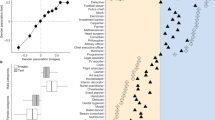Abstract
Previous research into gender role stereotypesin the mass media has focused on television, radio andmagazines. The present study sought to determine whethersimilar patterns can be found in photographic images of women in college-level HumanSexuality and Marriage and Family textbooks. Over 1000photographs of women were content analyzed. Resultsindicated that in the 1970s, photographs were devotedprimarily to traditional images of women. In the 1990s,while there were more photographs of women devoted tofeminist messages, photographs with traditional messagesstill dominated. The findings are discussed in terms of their implications for studies ofgender role development.
Similar content being viewed by others
REFERENCES
Apple, M. W. (1985). The culture and commerce of the textbook. Journal of Curriculum Studies, 17, 147–162.
Basow, S. (1986). Gender stereotypes. Belmont, CA: Brooks-Cole.
Barthes, R. (1977). Image-music-text. New York: Hill & Wang.
Bem, S. L. (1993). The lenses of gender: Transforming the debate on sexual inequality. New Haven, CT: Yale University Press.
Betz, N. (1993). Women' s career development. In F. L. Denmark & M. A. Paludi (Eds.), Psychology of women: A handbook of issues and theories. Greenwood Press: Westwood, CT.
Butler, M., & Paisley, W. (1980). Women and the mass media. New York: Human Sciences Press.
Craig, R. S. (1992). The effect of television day part on gender role portrayals in television commercials: A content analysis. Sex Roles, 26, 197–211.
Denmark, F. L. (1982). Integrating the psychology of women into introductory psychology. In C. J. Scherere & A. R. Rogers (Eds.), The G.Stanley Hall Lecture Series (Vol. 3). Washington, DC: APA.
Durkin, K. (1985). Television, sex roles and children: A developmental social psychology account. Milton Keynes: Open University Press.
Furnham, A., & Scho®eld, S. (1986). Sex role stereotyping in British radio advertisements. British Journal of Social Psychology, 25, 165–171.
Golombok, S., & Fivush, R. (1994). Gender development. Cambridge: Cambridge University Press.
Hurtz, W., & Durkin, K. (1997). Gender role stereotyping in Australian radio commercials. Sex Roles, 36, 101–114.
Huston, A. C. (1985). The development of sex typing: Themes from recent research. Developmental Review, 5, 1–17.
Kassarjian, H. H. (1977). Content analysis in consumer research. Journal of Consumer Research, 4, 8–18.
Meece, J. (1987). The in¯ uence of school experiences on the development of gender schemata. New Directions for Child Development, 38, 57–73.
Mitchell, J., & Oakley, A. (1986). What is feminism? New York: Pantheon Books.
Peterson, S. B., & Kroner, T. (1992). Gender biases in textbooks for introductory psychology and human development. Psychology of Women Quarterly, 16, 17–36.
Pierce, K. (1990). A feminist theoretical perspective on the socialization of teenage girls through Seventeen magazine. Sex Roles, 23, 491–500.
Percival, E. (1984). Sex bias in introductory psychology textbooks: Five years later. Canadian Psychology, 25, 35–42.
Reep, D. C., & Dambrot, F. H. (1987). Having it all? Care er con¯ icts for TV' s women. Journal of Studies in Technical Careers, 9, 217–233.
Reese, L. (1994). Gender equity and texts. Social Studies Review, 33, 12–15.
Rossi, S. R.,& Rossi, J. S. (1985). Gender differences in the perception of women in magazine advertising. Sex Roles, 12, 1033–1039.
Sadker, M. P.,& Sadker, D.M. (1980). Sexism in teacher education texts. Harvard Educational Review, 50, 36–45.
Sadker, M. P., & Sadker, D. M. (1994). Failing at fairness: How America's schools cheat girls. New York: C. Scribner' s Sons.
Schau, C. G., & Scott, K. P. (1984). Impact of gender characteristics of instructional materials: An integration of the research literature. Journal of Educational Psychology, 76, 183–193.
Schlenker, J. A., Caron, S. L., & Halteman, W. A. (1998). A feminist analysis of Seventeen magazine: Content analysis from 1945 to 1995. Sex Roles, 38, 135–148.
Sontag, S. (1977). On photography. New York: Farrar, Straus & Giroux.
Strong, B., & DeVault, C. (1997). Human sexuality: Diversity in contemporary America. Mountain View, CA: May® eld Publishing Company.
Whatley, M. H. (1988). Photographic images of Blacks in sexuality texts. Curriculum Inquiry, 18, 137–155.
Whatley, M. H. (1992). Images of gays and lesbians in Sexuality and Health textbooks. Journal of Homosexuality, 15, 197–211.
Rights and permissions
About this article
Cite this article
Low, J., Sherrard, P. Portrayal of Women in Sexuality and Marriage and Family Textbooks: A Content Analysis of Photographs from the 1970s to the 1990s. Sex Roles 40, 309–318 (1999). https://doi.org/10.1023/A:1018859207448
Issue Date:
DOI: https://doi.org/10.1023/A:1018859207448



